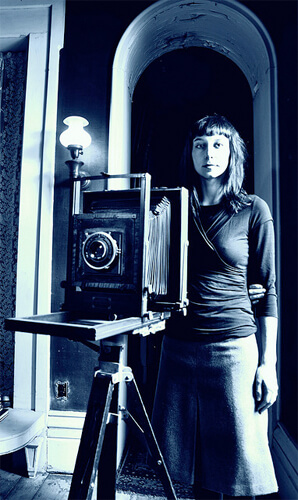Lauren Semivan (b. 1981) was born in Detroit, Michigan. She received a BA in studio art from Lawrence University in Appleton, Wisconsin, and an MFA in photography from Cranbrook Academy of Art. Her work has been exhibited at the Nelson Atkins Museum of Art, Detroit Center for Contemporary Photography, The Griffin Museum of Photography, The Hunterdon Art Museum, Cranbrook Art Museum, Paris Photo, and The AIPAD Photography Show among others. She has taught photography at College for Creative Studies, The Ohio State University, Virginia Commonwealth University, and Wayne State University.
Semivan has received numerous awards for her work including Photolucida Critical Mass Top 50, and The Griffin Museum of Photography’s Griffin Award. In 2014, she was a finalist for The John Gutmann Photography Fellowship, and SF Camerawork’s Baum Award for Emerging Photographers. Her work was recently published in Series of Dreams (Skeleton Key Press, 2018) and has appeared in The New Yorker, Artforum, Harper's Magazine, Interview Magazine, The Village Voice, and Photograph magazine. Semivan’s work is part of permanent collections at the Nelson Atkins Museum of Art, Cranbrook Art Museum, The Wriston Art Galleries at Lawrence University, and The Elton John Photography Collection. She lives in Appleton, WI and is represented by Benrubi Gallery in New York, and David Klein Gallery in Detroit, Michigan.
Artist Statement
"The staged photograph exists as a document of a pre-conceived, imagined event. It can be compared to a scientific apparatus, utilizing both control and the unknown. My ongoing body of work, Observatory, combines drawing, an archive of objects, and the human presence as a narrative tool. In scientific disciplines, a line is classified as an event. Something as primitive as a scrawl on a surface reveals an aggregate of events, intersecting and changing course. Drawings made on the seamless backdrop describe an emotional space. Science is inherently experiential, as is art making. Knowing and feeling are not separate, and the whole of the environment can be used as a pedagogic instrument. Observatory elegantly draws upon a tension that exists between irrational and physical worlds. Within each image, ghosts of previous drawings create a sense of time suspended, evoking gesture, atmosphere and memory. Photographs allow me to access the extraordinary, to keep a record of dreams, and to employ the unknown. My interest in photography is interdisciplinary and synergistic, informed by the written word, painting, drawing, sculpture, and the raw material of human experience. All images are made using an early 20th century 8x10" view camera. Large format negatives are scanned and printed without digital manipulation in editions of 5 (40"x50") and 10 (24"x30")."
Source: www.laurensemivan.com
Her ongoing body of work, Observatory, combines drawing, an archive of objects, and the human presence as a narrative tool. Within each image, ghosts of previous drawings create a sense of time suspended, evoking gesture, atmosphere and memory. "Photographs allow me to access the extraordinary, to keep a record of dreams, and to employ the unknown. Science is inherently experiential, as is art making. Knowing and feeling are not separate, and the whole of the environment can be used as a pedagogic instrument. Observatory elegantly draws upon a tension that exists between irrational and physical worlds".
Semivan’s work resides in the collections of the Nelson Atkins Museum, Cranbrook Art Museum, and the Wriston Art Center at Lawrence University, and has been featured in Wall Street International Magazine, the New Yorker, Artforum, and Photograph magazine.
Source: Benrubi Gallery
